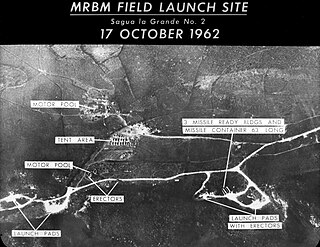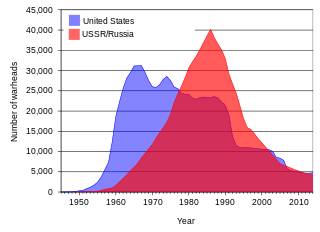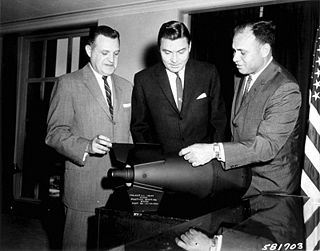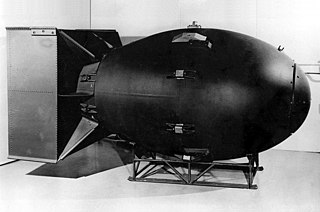Related Research Articles

A nuclear weapon is an explosive device that derives its destructive force from nuclear reactions, either fission or from a combination of fission and fusion reactions. Both bomb types release large quantities of energy from relatively small amounts of matter. The first test of a fission ("atomic") bomb released an amount of energy approximately equal to 20,000 tons of TNT (84 TJ). The first thermonuclear ("hydrogen") bomb test released energy approximately equal to 10 million tons of TNT (42 PJ). A thermonuclear weapon weighing little more than 2,400 pounds (1,100 kg) can release energy equal to more than 1.2 million tons of TNT (5.0 PJ). A nuclear device no larger than traditional bombs can devastate an entire city by blast, fire, and radiation. Since they are weapons of mass destruction, the proliferation of nuclear weapons is a focus of international relations policy.

Strategic Air Command (SAC) was both a United States Department of Defense (DoD) Specified Command and a United States Air Force (USAF) Major Command (MAJCOM), responsible for Cold War command and control of two of the three components of the U.S. military's strategic nuclear strike forces, the so-called "nuclear triad", with SAC having control of land-based strategic bomber aircraft and intercontinental ballistic missiles or ICBMs.

Nuclear warfare is a military conflict or political strategy in which nuclear weaponry is used to inflict damage on the enemy. Nuclear weapons are weapons of mass destruction; in contrast to conventional warfare, nuclear warfare can produce destruction in a much shorter time and can have a long-lasting radiological warfare result. A major nuclear exchange would have long-term effects, primarily from the fallout released, and could also lead to a "nuclear winter" that could last for decades, centuries, or even millennia after the initial attack. Some analysts dismiss the nuclear winter hypothesis, and calculate that even with nuclear weapon stockpiles at Cold War highs, although there would be billions of casualties, billions more rural people would nevertheless survive. However, others have argued that secondary effects of a nuclear holocaust, such as nuclear famine and societal collapse, would cause almost every human on Earth to starve to death.

World War III and the Third World War are names given to a hypothetical third worldwide large-scale military conflict subsequent to World War I and II. The term has been in use since at least as early as 1941. Some have applied it loosely to refer to limited or smaller conflicts such as the Cold War or the War on Terror, while others assumed that such a conflict would surpass prior world wars both in its scope and in its destructive impact.

Brinkmanship is the practice of trying to achieve an advantageous outcome by pushing dangerous events to the brink of active conflict. It occurs in international politics, foreign policy, labor relations, and military strategy involving the threat of nuclear weapons, and high-stakes litigation. This maneuver of pushing a situation with the opponent to the brink succeeds by forcing the opponent to back down and make concessions. This might be achieved through diplomatic maneuvers by creating the impression that one is willing to use extreme methods rather than concede. The term is chiefly associated with American Secretary of State John Dulles, during the early years of the Eisenhower administration 1953-1956. Dulles sought to deter aggression by the Soviet Union by warning that the cost might be massive retaliation against Soviet targets.

The defense readiness condition (DEFCON) is an alert state used by the United States Armed Forces.

Nuclear weapons tests are experiments carried out to determine the effectiveness, yield, and explosive capability of nuclear weapons. Testing nuclear weapons offers practical information about how the weapons function, as well as how detonations are affected by different conditions; and how personnel, structures, and equipment are affected when subjected to nuclear explosions. However, nuclear testing has often been used as an indicator of scientific and military strength, and many tests have been overtly political in their intention; most nuclear weapons states publicly declared their nuclear status by means of a nuclear test.

Hugh Everett III was an American physicist who first proposed the many-worlds interpretation (MWI) of quantum physics, which he termed his "relative state" formulation. In contrast to the then-dominant Copenhagen interpretation, the MWI posits that the Schrödinger equation never collapses and that all possibilities of a quantum superposition are objectively real.

The nuclear arms race was an arms race competition for supremacy in nuclear warfare between the United States, the Soviet Union, and their respective allies during the Cold War. During this very period, in addition to the American and Soviet nuclear stockpiles, other countries developed nuclear weapons, though none engaged in warhead production on nearly the same scale as the two superpowers.

The Single Integrated Operational Plan (SIOP) was the United States' general plan for nuclear war from 1961 to 2003. The SIOP gave the President of the United States a range of targeting options, and described launch procedures and target sets against which nuclear weapons would be launched. The plan integrated the capabilities of the nuclear triad of strategic bombers, land-based intercontinental ballistic missiles (ICBM), and sea-based submarine-launched ballistic missiles (SLBM). The SIOP was a highly classified document, and was one of the most secret and sensitive issues in U.S. national security policy.

Since their public debut in August 1945, nuclear weapons and their potential effects have been a recurring motif in popular culture, to the extent that the decades of the Cold War are often referred to as the "atomic age".

The United States was the first country to manufacture nuclear weapons and is the only country to have used them in combat, with the separate bombings of Hiroshima and Nagasaki in World War II. Before and during the Cold War, it conducted over a thousand nuclear tests and tested many long-range nuclear weapons delivery systems.

A tactical nuclear weapon (TNW) or non-strategic nuclear weapon is a nuclear weapon which is designed to be used on a battlefield in military situations mostly with friendly forces in proximity and perhaps even on contested friendly territory. Generally smaller in explosive power, they are defined in contrast to strategic nuclear weapons: which are designed to be mostly targeted in the enemy interior away from the war front against military bases, cities, towns, arms industries, and other hardened or larger-area targets to damage the enemy's ability to wage war.

The Institute for Defense Analyses (IDA) is an American non-profit corporation that administers three federally funded research and development centers (FFRDCs) – the Systems and Analyses Center (SAC), the Science and Technology Policy Institute (STPI), and the Center for Communications and Computing (C&C) – to assist the United States government in addressing national security issues, particularly those requiring scientific and technical expertise. It is headquartered in Alexandria, Virginia.
World War III is a common theme in popular culture. Since the 1940s, countless books, films, and television programmes have used the theme of nuclear weapons and a third global war. The presence of the Soviet Union as an international rival armed with nuclear weapons created a persistent fear in the United States and vice versa. There was a pervasive dread of a nuclear World War III, and popular culture reveals the fears of the public at the time. This theme in the arts was also a way of exploring a range of issues far beyond nuclear war. The historian Spencer R. Weart called nuclear weapons a "symbol for the worst of modernity."

A strategic nuclear weapon refers to a nuclear weapon which is designed to be used on targets often in settled territory far from the battlefield as part of a strategic plan, such as military bases, military command centers, arms industries, transportation, economic, and energy infrastructure, and heavily populated areas such as cities and towns, which often contain such targets. It is in contrast to a tactical nuclear weapon, which is designed for use in battle, as part of an attack with and often in close proximity to friendly conventional forces possibly on contested friendly territory.

A nuclear holocaust, nuclear apocalypse or atomic holocaust is a theoretical scenario involving widespread destruction and radioactive fallout causing the collapse of civilization, through the use of nuclear weapons. Under such a scenario, some or all of the Earth is made uninhabitable by nuclear warfare in future world wars.
This timeline of nuclear weapons development is a chronological catalog of the evolution of nuclear weapons rooting from the development of the science surrounding nuclear fission and nuclear fusion. In addition to the scientific advancements, this timeline also includes several political events relating to the development of nuclear weapons. The availability of intelligence on recent advancements in nuclear weapons of several major countries is limited because of the classification of technical knowledge of nuclear weapons development.
References
- ↑ Fay, Elton C. (1950-10-13). "Appraisal of Weapons used in Korea Due". TimesDaily . Associated Press . Retrieved 2011-09-01.
- ↑ "Weapons' Values to be Appraised". Spokane Daily Chronicle . Associated Press. 1948-12-15. Retrieved 2011-09-01.
- ↑ Hoffman, Fred S. (1973-12-18). "Effectiveness of Soviet anti-aircraft missile surprising". The Leader-Post . Associated Press . Retrieved 2011-09-01.
- ↑ Hugh Everett III and George E. Pugh, "The Distribution and Effects of Fallout in Large Nuclear-Weapon Campaigns", in Biological and Environment Effects of Nuclear War, Hearings Before the Special Sub-Committee on Radiation of the Joint Congressional Committee on Atomic Energy, June 22–26, 1959, Washington, D.C., U.S. Government Printing Office, 1959.